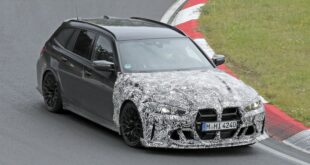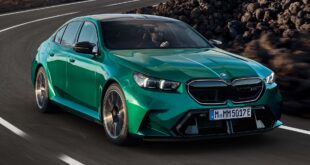 Car and Driver reviews the 2014 BMW 535i xDrive against the 2014 Cadillac CTS 3.6, 2014 Audi A6 3.0T and 2014 Mercedes-Benz E350. The 2014 BMW 535i xDrive is powered by a 3.0-liter six-cylinder turbocharged engine developing 306 HP and 450 Nm (332 lb-ft) of torque. Mercedes-Benz E350 is using a 3.5-liter V6 that makes 306 HP and 273 lb-ft (370 Nm) of torque, matted to a 7-speed automatic transmission. Cadillac CTS used a 3.6-liter naturally aspirated V6 engine producing 326 HP and 275 lb-ft (372 Nm) of torque, and mated to an 8-speed automatic. The Audi A6 3.05 T is powered by a 3.0 TSI engine that makes 310 HP and 325 lb-ft (440 Nm) of torque. So which one is better? Learn on this excerpt below:
Car and Driver reviews the 2014 BMW 535i xDrive against the 2014 Cadillac CTS 3.6, 2014 Audi A6 3.0T and 2014 Mercedes-Benz E350. The 2014 BMW 535i xDrive is powered by a 3.0-liter six-cylinder turbocharged engine developing 306 HP and 450 Nm (332 lb-ft) of torque. Mercedes-Benz E350 is using a 3.5-liter V6 that makes 306 HP and 273 lb-ft (370 Nm) of torque, matted to a 7-speed automatic transmission. Cadillac CTS used a 3.6-liter naturally aspirated V6 engine producing 326 HP and 275 lb-ft (372 Nm) of torque, and mated to an 8-speed automatic. The Audi A6 3.05 T is powered by a 3.0 TSI engine that makes 310 HP and 325 lb-ft (440 Nm) of torque. So which one is better? Learn on this excerpt below:
The only car in this comparison that confounds us as much as the gaming den, the 535i xDrive seems to have lost touch with what once made us go gaga for the model. Alterman wrote down what we were all thinking: “There’s very little of the E39 [1997–2003] left in the 5-series. Now it feels like a big cruiser.â€
Indeed, the notebook was overflowing with various ways to describe the 5-series as large and ponderous. It’s clear that shortly after inspiring Cadillac to build lively sedans, BMW left that territory for the taking. While the heaviest entrant at 4187 pounds complete with four-wheel-drive hardware, the BMW is bigger than the other three cars only in its wheelbase, trunk, and front-seat space. It’s the car’s deportment that leaves the lumbering impression. Its fat, large-diameter steering wheel commands a steering system that feels distant and a little slow-witted. The 535i doesn’t turn in readily. Instead it takes a two-stage approach to cornering. Turn-in is accompanied by enough load transfer and body roll to sow doubt about the car’s ability. Then it settles in and delivers the test’s second-best level of grip (0.86 g). But the experience is never exactly fun or confidence-inspiring. And the slowest-in-test slalom performance (40.1 mph) reveals its ultimately messy transitional behavior.
So the BMW has become something of a cruiser. That’s okay if you like that sort of thing, right? Well, it would be if it delivered the ride quality to match the test’s other cruiser, the Mercedes. But it doesn’t. It feels heavy-footed and clomps loudly over broken pavement. And over one particularly abrupt undulation on our handling loop, the 5’s suspension wanted to bottom out, where the other three cars took the hillock with considerably less drama. We suspect driving a 7-series on the same roads wouldn’t feel much different.
 BMW.SG | BMW Singapore Owners Community The Ultimate BMW Community – Established Since 2001
BMW.SG | BMW Singapore Owners Community The Ultimate BMW Community – Established Since 2001













